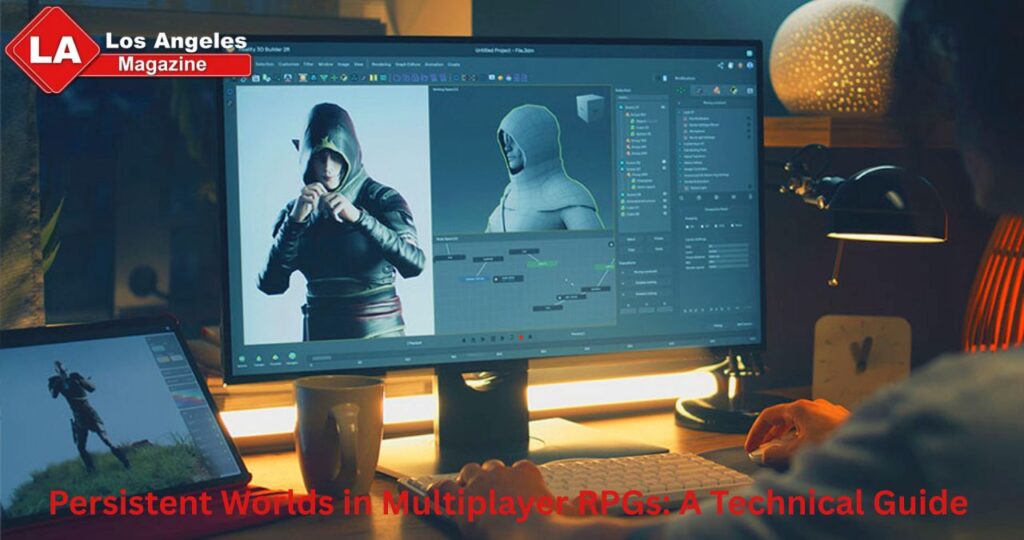Creating persistent worlds for multiplayer role-playing games (RPGs) stands as a monumental task, demanding both innovative design and robust technological infrastructure. As the gaming industry evolves, the desire for immersive, consistent worlds grows more intense, challenging developers to push beyond conventional boundaries. This guide delves into the technical underpinnings and creative intricacies essential for crafting these expansive universes, offering insights that cater to leading game developer companies, video game journalists, and content strategy managers alike.
What is a Persistent World?
A persistent world continues to function even when players are offline. It reflects player actions over time, maintains continuity, and evolves without resetting. This creates a sense of consequence, immersion, and community that separates multiplayer RPGs from static or session-based games.
Defining the Persistent World
A persistent world is a dynamic, constantly evolving space. Unlike games that pause when players leave, persistent worlds retain every action, environmental change, and player-driven event. Maintaining this continuity requires a technical backbone capable of tracking countless variables and keeping all systems synchronized.
The Role of Time
Time doesn’t stop in a persistent world. Seasons shift, characters age, and storylines progress even when players are away. Developers must design systems that reflect this continuous passage—weather systems, evolving political dynamics, and time-based events that reward consistent participation while allowing re-entry at any point.
Community and Shared Experience
Persistent worlds are social by nature. Players contribute to a shared history, impacting the environment and storyline. Whether through cooperation, rivalry, or economic interaction, the player community becomes a driving force in world evolution. This reinforces long-term engagement and creates a stronger sense of ownership and investment.
Core Elements of Persistence
- Continuity and Evolution
The world reflects the collective actions of its players—story arcs progress, factions shift, environments change. - Scalability
Infrastructure must grow with the user base while maintaining performance and stability. - Stability and Reliability
Persistent worlds must be available 24/7. Downtime risks disrupting immersion and trust.
Technical Infrastructure
Creating a persistent multiplayer RPG hinges on a solid tech stack that supports real-time updates, data integrity, and seamless scalability.
Server Architecture
The server is the lifeblood of any multiplayer game. A distributed architecture is key to maintaining uptime, reducing latency, and allowing for flexible scaling.
Distributed Server Models
Using a geographically distributed server model helps reduce latency and prevent single points of failure. This setup allows servers closer to the player base to handle requests, improving performance and responsiveness.
Cloud Computing Advantages
Services like AWS and Azure offer scalable cloud infrastructure. With on-demand resources, developers can dynamically allocate computing power based on player traffic, reducing costs during off-peak times and handling surges during major events or expansions.
Advanced Database Management
Databases in persistent games must manage high volumes of unstructured data. NoSQL databases such as MongoDB and Cassandra offer horizontal scalability and support for high throughput.
- Horizontal Scaling: Easily adds capacity as world size and player data grow.
- Indexing and Caching: Speeds up data access, essential for real-time gameplay responsiveness.
Synchronization and Data Consistency
To ensure all players see the same world state, developers need strong sync systems.
Real-Time Updates
Data pipelines must deliver changes instantly, updating clients with minimal lag and handling interruptions gracefully.
Conflict Resolution Mechanisms
Simultaneous actions from multiple players can cause inconsistencies. Conflict-Free Replicated Data Types (CRDTs) help resolve these issues without data loss or duplication.
Ensuring Data Integrity
Consistency and reliability are non-negotiable. Strategies include:
- Regular data backups
- Redundant data centers
- Error-detection and correction protocols
Narrative and Gameplay Design
Infrastructure keeps the world online. Narrative design keeps it compelling.
Dynamic Storytelling
Persistent worlds need flexible storytelling that adapts to player choices and scales over time.
Adaptive Narratives
Branching quests and player decisions shape unique outcomes. This demands a well-structured narrative engine with memory and adaptability.
Procedural Content Generation
Algorithms can generate new quests, terrain, and challenges. This keeps the world feeling fresh without placing endless demand on content teams.
Player-Driven Story Arcs
Giving players influence over major storylines creates a sense of ownership. This requires systems that can track decisions and reflect them in world events.
Player Interaction and Community Building
Persistent games thrive on social systems that promote interaction and long-term engagement.
Social Structures and Guilds
Guild systems let players form alliances and build in-game communities. These groups often drive in-game politics, economy, and cooperative play.
Trade Systems and Player Economy
A robust economy encourages specialization and collaboration. Dynamic pricing, item scarcity, and player-run markets add depth and realism.
Cooperative Gameplay Mechanics
Group-based challenges, raids, and faction goals encourage teamwork and reinforce community bonds. These mechanics must be balanced to remain inclusive to new players.
Challenges and Solutions
Persistent world development brings both technical and design hurdles.
Technical Challenges
- Latency and Lag: Must be mitigated with efficient network protocols and client-side prediction.
- Security and Anti-Cheat: Use encryption, real-time monitoring, and behavioral analysis to prevent exploits.
Optimizing Network Protocols
Minimize bandwidth use, compress data packets, and anticipate player actions to smooth out latency.
Robust Security Measures
Encrypt traffic, secure APIs, and use anomaly detection to identify suspicious behavior.
Anti-Cheating Mechanisms
Server-side validation and monitoring tools protect fairness and game integrity.
Design Challenges
- Balancing Progression: Ensure new players can catch up while veterans stay challenged.
- Content Fatigue: Address with regular updates, player events, and a mix of procedural and handcrafted content.
Fair Progression Systems
Design flexible systems that reward effort but allow new players to engage without major disadvantages.
Sustainable Content Creation
Use procedural generation and community feedback to fuel updates. Regular seasonal events and expansions keep interest high.
Community-Driven Events
Let players shape world events. Scheduled tournaments, building competitions, or narrative votes keep the community invested.
Future Trends in Persistent Worlds
The future of persistent RPGs lies in intelligent systems and deeper immersion.
AI and Machine Learning
Smart systems can personalize gameplay and adapt world behaviors based on data.
Dynamic NPC Behavior
AI-driven NPCs learn from player interactions and change accordingly, offering more realistic and reactive storytelling.
Personalized Content Delivery
ML models adjust quest difficulty, offer tailored events, and predict player preferences.
Predictive Game Design
Analytics can inform future updates and design changes, keeping developers aligned with player behavior.
VR and AR Integration
Virtual and augmented reality technologies are unlocking new layers of immersion.
Enhanced Immersion (VR)
VR technology can provide an unparalleled level of immersion, transporting players directly into the game world. By offering a 360-degree perspective and intuitive controls, VR can create a deeply engaging experience that traditional gaming cannot match. This heightened immersion can make persistent worlds feel more alive, enhancing player attachment and investment. For developers looking to develop VR game environments that captivate users, focusing on immersion and interaction is key to long-term engagement.
Augmented Reality Possibilities
AR brings the game into the real world, enabling location-based gameplay and social discovery.
New Interaction Models
Gesture controls, voice commands, and spatial inputs redefine how players experience and affect the world.
Conclusion
Persistent worlds represent the next frontier in multiplayer RPGs—demanding powerful infrastructure, flexible design, and a focus on player agency. Developers who master these elements can create living, breathing game worlds that keep players returning, evolving, and engaging for years. As AI, VR, and cloud computing continue to advance, the boundaries of what’s possible will only expand.



